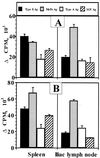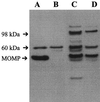Prior genital tract infection with a murine or human biovar of Chlamydia trachomatis protects mice against heterotypic challenge infection
- PMID: 10338514
- PMCID: PMC96615
- DOI: 10.1128/IAI.67.6.3019-3025.1999
Prior genital tract infection with a murine or human biovar of Chlamydia trachomatis protects mice against heterotypic challenge infection
Abstract
We sought to assess the degree of cross-protective immunity in a mouse model of chlamydial genital tract infection. Following resolution of genital infection with the mouse pneumonitis (MoPn) biovar of Chlamydia trachomatis, mice were challenged intravaginally with either MoPn or human serovar E or L2. The majority of animals previously infected with MoPn were solidly immune to challenge with either of the two human biovars. Surprisingly, approximately 50% of animals became reinfected when homologously challenged with MoPn, although the secondary infection yielded significantly lower numbers of the organism isolated over a shorter duration than in the primary infection. Primary infection with serovar E also protected against challenge with MoPn or serovar L2, although the degree of immune protection was lower than that resulting from primary infection with MoPn. Blast transformation and assessment of delayed-type hypersensitivity indicated that mice previously infected with either human or murine biovars produced broadly cross-reactive T cells that recognized epitopes of either murine or human biovars of C. trachomatis. Immunoblotting demonstrated that primary MoPn infection produced immunoglobulin G (IgG) antibody to antigens of MoPn as well as at least three distinct antigenic components of human serovar E, one of which was identical in molecular weight to the major outer membrane protein (MOMP). Primary infection with serovar E produced IgG antibody reactive against serovar E but not MoPn MOMP and against at least one ca. 60-kDa protein of both chlamydial strains. Our results indicate that primary genital infection of mice with murine C. trachomatis induces immunity against challenge with either of two human biovars.
Figures




Similar articles
-
Monoclonal immunoglobulin A antibody to the major outer membrane protein of the Chlamydia trachomatis mouse pneumonitis biovar protects mice against a chlamydial genital challenge.Vaccine. 1997 Apr;15(5):575-82. doi: 10.1016/s0264-410x(97)00206-5. Vaccine. 1997. PMID: 9160528
-
Expression of mucosal homing receptor alpha4beta7 is associated with enhanced migration to the Chlamydia-infected murine genital mucosa in vivo.Infect Immun. 2000 Oct;68(10):5587-94. doi: 10.1128/IAI.68.10.5587-5594.2000. Infect Immun. 2000. PMID: 10992458 Free PMC article.
-
Local Th1-like responses are induced by intravaginal infection of mice with the mouse pneumonitis biovar of Chlamydia trachomatis.Infect Immun. 1995 May;63(5):1784-9. doi: 10.1128/iai.63.5.1784-1789.1995. Infect Immun. 1995. PMID: 7729886 Free PMC article.
-
Immunization with the Chlamydia trachomatis mouse pneumonitis major outer membrane protein by use of CpG oligodeoxynucleotides as an adjuvant induces a protective immune response against an intranasal chlamydial challenge.Infect Immun. 2002 Sep;70(9):4812-7. doi: 10.1128/IAI.70.9.4812-4817.2002. Infect Immun. 2002. PMID: 12183524 Free PMC article.
-
Protective immunity to Chlamydia trachomatis genital infection: evidence from human studies.J Infect Dis. 2010 Jun 15;201 Suppl 2(S2):S178-89. doi: 10.1086/652400. J Infect Dis. 2010. PMID: 20524235 Free PMC article. Review.
Cited by
-
Dendrimer-conjugated peptide vaccine enhances clearance of Chlamydia trachomatis genital infection.Int J Pharm. 2017 Jul 15;527(1-2):79-91. doi: 10.1016/j.ijpharm.2017.05.045. Epub 2017 May 22. Int J Pharm. 2017. PMID: 28546072 Free PMC article.
-
Animal models for studying female genital tract infection with Chlamydia trachomatis.Infect Immun. 2013 Sep;81(9):3060-7. doi: 10.1128/IAI.00357-13. Epub 2013 Jul 8. Infect Immun. 2013. PMID: 23836817 Free PMC article. Review.
-
Preclinical screen for protection efficacy of chlamydial antigens that are immunogenic in humans.Infect Immun. 2023 Nov 16;91(11):e0034923. doi: 10.1128/iai.00349-23. Epub 2023 Oct 27. Infect Immun. 2023. PMID: 37889004 Free PMC article.
-
Acquired homotypic and heterotypic immunity against oculogenital Chlamydia trachomatis serovars following female genital tract infection in mice.BMC Infect Dis. 2005 Nov 17;5:105. doi: 10.1186/1471-2334-5-105. BMC Infect Dis. 2005. PMID: 16293190 Free PMC article.
-
Vaccination with the Chlamydia trachomatis major outer membrane protein can elicit an immune response as protective as that resulting from inoculation with live bacteria.Infect Immun. 2005 Dec;73(12):8153-60. doi: 10.1128/IAI.73.12.8153-8160.2005. Infect Immun. 2005. PMID: 16299310 Free PMC article.
References
-
- Barron A L, White H J, Rank R G, Soloff B L, Moses E B. A new animal model for the study of Chlamydia trachomatis genital infections: infection of mice with the agent of mouse pneumonitis. J Infect Dis. 1981;143:63–66. - PubMed
-
- Brunham R C. Vaccine design for the prevention of Chlamydia trachomatis infection. In: Orfila J, Byrne G I, Chernesky M A, Grayston J T, Jones R B, Ridgway G L, Saikku P, Schachter J, Stamm W E, Stephens R S, editors. Chlamydial infections: proceedings of the Eighth International Symposium on Human Chlamydial Infections. Bologna, Italy: Societa Editrice Esculapio; 1994. pp. 73–82.
-
- Brunham R C, Peeling R, Maclean I, McDowell J, Persson K, Osser S. Postabortal Chlamydia trachomatis salpingitis: correlating risk with antigen-specific serological responses and with neutralization. J Infect Dis. 1987;55:749–755. - PubMed
Publication types
MeSH terms
Substances
Grants and funding
LinkOut - more resources
Full Text Sources
Other Literature Sources
Medical
Molecular Biology Databases
Research Materials

